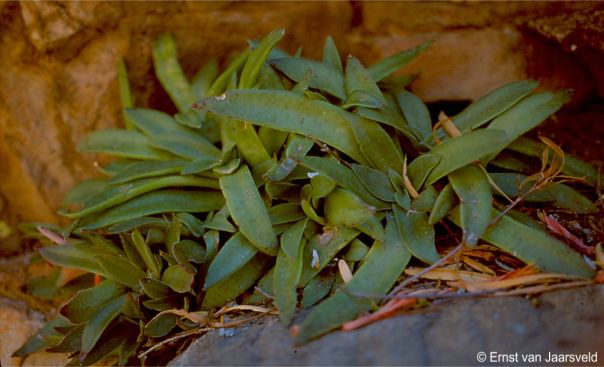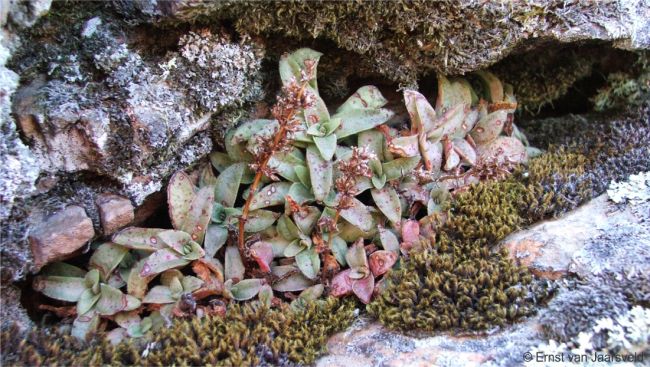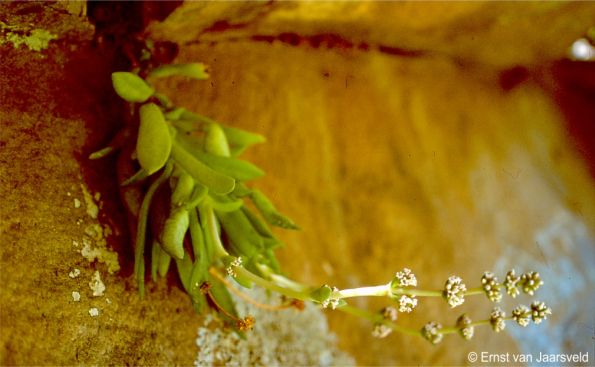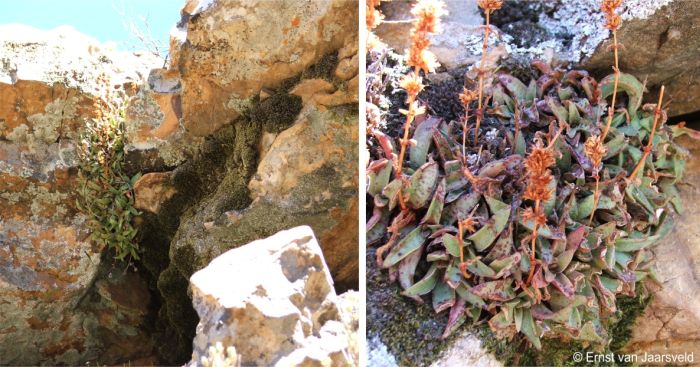Crassula brachystachya
Crassula brachystachya Toelken
Family: Crassulaceae
Common names: cliff-crassula (Eng.), kransrosie (Afr.)
Introduction
Crassula brachystachya is a rare, cluster-forming, cliff-hugging succulent to 70 mm high, with leaves in a rosette and an ascending, spike-like inflorescence in summer, bearing white, tubular flowers. Confined to the lower northern slopes of the Swartberg in the Klein Karoo, Western Cape and northwards to Calvinia in the Northern Cape. Best for containers.

Fig. 1. Crassula brachystachya in flower in its habitat at Bosluiskloof, Klein Swartberg, growing on a rocky sandstone ledge.
Description
Description
Plants rosulate, solitary or proliferating from the base to form small, dense clusters, all parts fragile, brittle. Roots fleshy, up to 3 mm in diameter. Branches short but sometimes up to 100 mm long. Leaves in basal rosettes up to 150 (–240) mm in diameter, spirally arranged, oblanceolate-oblong, (20–)30–80(–120) × 4–15(–20) mm; surface glabrous, dotted with crateriform hydathodes, spotted purplish towards the apex; margin ciliate; apex acute. Inflorescence a spike-like thyrse (rarely up to 3), 110–230 mm high, bearing sessile dichasia on a distinct peduncle; bracts triangular-ovate, 12 × 9 mm, ciliate. Calyx lobes oblong-elliptic, 3.5–4.5 mm, ciliate. Corolla tubular, 6 mm long; lobes oblong, 4–5 mm long, fused shortly at base, apices spreading, white. Flowering time is in summer (November–January).

Fig. 2. Crassula brachystachya in its cliff-face habitat, at Bosluiskloof, Klein Swartberg, growing on a sandstone ledge.
Conservation Status
Status
Assessed as Rare by the Red List of South African Plants, Crassula brachystachya is a range-restricted habitat specialist and not common locally, but it faces no threats and is well protected by its inaccessible cliff habitat.

Fig. 3. The broken cliff at Tuinskloof, Touwsrivier, Western Cape, habitat of Crassula brachystachya.
Distribution and habitat
Distribution description
Crassula brachystachya grows widespread in the Western Cape but is nowhere common. From Bosluiskloof in the Klein Swartberg in the east and further to the northwest to the Touwsrivier District in the Western Cape. James Deacon found a population further north at Loeriesfontein in the Northern Cape. It grows at an altitude of 1 300–2 000 m. The plants grow on sheltered to exposed cliffs, in shallow soil among leaf litter on shady rocky ledges. Temperature is moderate in summer and mild in winter. Average daily maximum temperature is 20–23°C and daily minimum 5–8°C. Rainfall in winter (cyclonic) and summer, ranging from 200–400 mm per annum.
The associated vegetation consists of Western Little Karoo of the Succulent Karoo Biome (Mucina et al. 2005). At Besemfonteinkloof plants grow with Aloe perfoliata, Drimia uniflora, Crassula rupestris subsp. rupestris and Euphorbia multifolia. The geology consists of quartzitic sandstone of the Table Mountain and Witpoort Formation (Cape Supergroup). At Tuinskloof, north of Touwsrivier plants were found growing on cliffs among moss in Matjiesfontein quartz fynbos vegetation (Mucina et al 2006).

Fig. 4. Crassula brachystachya growing among moss on a cliff at Tuinskloof, Touwsrivier.
Derivation of name and historical aspects
History
Crassula brachystachya was named by Helmut Toelken in the Journal of South African Botany in 1975 from plants collected at Wittekloof by Harold Compton, second director of Kirstenbosch National Garden. It was also recorded by Rudolph Marloth and T.P. Stokoe. Toelken named his plant C. brachystachya meaning ‘short spike’ from the Greek brachys, meaning ‘short’, and stachys, ‘an ear of corn’ or ‘a spike’, pertaining to the sessile dichasia.
Crassula brachystachya belongs to section Rosulares which includes 22 species (Toelken 1985). It is related to C. capitella subsp. thyrsiflora, but is at once distinguished from this taxon by its distinct peduncle and abruptly shortened bracts.
In section Rosularis the following 13 taxa also are associated with cliffs. These include: Crassula cymbiformis, C. orbicularis, C. montana and its 3 subspecies, C. pseudohemisphaerica, C. luederitzii, C. cremnophila, C. socialis, C. exilis and its 2 subspecies, C. setulosa, C. sediflora, C. capitella, C. tomentosa subsp. glabrifolia and C. aurusbergensis. Of these species C. brachystachya is at once distinguished by its fairly large rosette with spike like thyrse and sessile dichasia.

Fig. 5. Crassula brachystachya in flower in its cliff-face habitat at Bosluiskloof, growing in a sandstone rock crevice below an overhang.
Ecology
Ecology
Crassula brachystachya is a fairly long-lived perennial succulent. The plant forms loose clusters. The succulent roots and leaves in a rosette enable the plant to survive on the dry cliff. The leaf epidermis is light green, becoming reddish during dry periods. The reddish colour, caused by the production of anthocyanins, reduces penetration of light and can be viewed as an adaptation to the xeric cliff conditions. The leaves are soft and fragile without conspicuous armament, suggesting adaptation to the cliff environment which is free of herbivores.
Flowering occurs in summer, from November to January, the conspicuous white flowers are pollinated by insects. The follicles are dehiscent, and the seeds are spontaneously released and dispersed by wind during summer, ready for the onset of autumn rains, maximising establishment. Seeds are minute and ideal for establishment in crevices.
Crassula brachystachya proliferates vegetatively, forming small mats and cushions, an efficient backup strategy for surviving the harsh conditions on the cliff face. When an offshoot, or a leaf becomes detached due to heavy wind or some other disturbance, it will root if it falls into a new crevice, ensuring long-term survival.

Fig. 6. Crassula brachystachya growing on a sandstone cliff at Tuinskloof, Touwsrivier and a close-up of a cluster on the cliff.
Uses
Use
It is not known whether the plants are used medicinally.
Growing Crassula brachystachya
Grow
Although Crassula brachystachya is not well-known in cultivation, it is fairly easy to grow and makes a beautiful small potplant. Best for succulent karoo gardens, in rockeries or containers. Outside its habitat it is best for miniature succulent gardens and containers grown under controlled conditions in a greenhouse. Grow in light shade or dappled shade. Soil should be sandy, slightly acidic and well-drained. Add ample compost or feed with a liquid organic fertiliser. Water well, but allow plants to dry out for some time before watering again. The stored moisture in their leaves and stems allow succulents to survive when no soil moisture is present. Leaves succumb to rust in moist coastal climates and slugs and snails and snout weevils can be a problem.
Propagate from seed or division. Best propagated by division of stolons. Plant offshoots in a sandy soil. Best time is in spring and summer. Roots are sometimes affected by mealybug, treat accordingly. Seed is fine and can be sown in a sandy mixture in autumn and cover with a very thin layer of gravel. Keep moist. Transplant seedlings as soon they are large enough to handle.
References
- Christenhusz, M.J.M., Fay, M.F. & Chase, M.W. 2017. Plants of the World, an illustrated Encyclopedia of vascular plants. Kew Publishing, Royal Botanic Gardens, Kew.
- Clarke, H. & Charters, M. 2016. The illustrated dictionary of southern African plant names. Flora & Fauna Publications Trust, Jacana, Johannesburg.
- Eggli, U. (ed.) 2003. Illustrated handbook of succulent plants: Crassulaceae. Springer, Berlin.
- Linnaeus, C. 1753. Species plantarum. 1st edition. Salvius, Stockholm.
- Mucina, L. & Rutherford, M.C. (eds) 2006. The vegetation of South Africa, Lesotho and Swaziland. Strelitzia 19. South African National Biodiversity Institute, Pretoria.
- Raimondo, D., Von Staden, L., Foden, W., Victor, J.E., Helme, N.A., Turner, R.C., Kamundi, D.A. & Manyama, P.A. (eds) 2009. Red list of South African plants. Strelitzia 25. South African National Biodiversity Institute, Pretoria.
- Rowley, G. 2003. Crassula: a growers guide. Cactus & Co. Vista, California.
- Toelken, H.R. 1975. New taxa and new combinations in the genus Crassula. Journal of South African Botany 41(2): 93–124.
- Toelken, H.R. 1985. Crassulaceae. Flora of Southern Africa 14: 1–244.
- Van Jaarsveld, E.J. & Van Wyk, A.E. 1999. Five new cremnophilous taxa from semi-arid regions in South Africa. Aloe 36 (4): 71–74).
Credits
Ernst van Jaarsveld
Kirstenbosch National Botanical Garden (Retired)
Babylonstoren Farm (Current)
Extraordinary senior lecturer and researcher,
Department of Biodiversity and Conservation, University of the Western Cape
August 2024
Plant Attributes:
Plant Type: Succulent
SA Distribution: Western Cape
Soil type: Sandy, Loam
Flowering season: Early Summer
PH: Acid, Neutral
Flower colour: White
Aspect: Shade, Morning Sun (Semi Shade), Afternoon Sun (Semi Shade)
Gardening skill: Average
Special Features:
Horticultural zones








Rate this article
Article well written and informative
Rate this plant
Is this an interesting plant?
Login to add your Comment
Back to topNot registered yet? Click here to register.